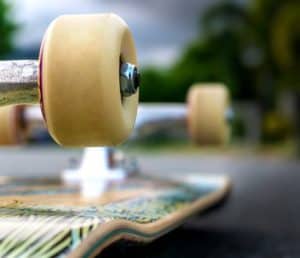Skateboarding is fun. It can also be ecofriendly
 16 April 2020
16 April 2020
Picture this: four wheels, a wooden board coated in glittery black griptape, and jukebox on the sidewalk. Skateboarding is the pinnacle of 1990s culture, and it’s making a comeback.
Skateboarders are called a lot of names: shredders, concrete surfers, hill bombers. Celebrated as a sport and a recreational activity and now seen as a mode of transportation, skateboarding has catapulted itself from the streets of Los Angeles to across the world.
It all started when surfers attached clay wheels to lumber boards and began skating across the new urban developments in southern California in the 1950s. Yet for decades skater counter culture has been intertwined with changes in the environment.
When a drought hit southern California, swimming pools dried up and the days of sidewalk skating suddenly found new habitats to flourish in. The empty pools, now abandoned in the wake of the drought, became grounds for skate tricks and flips to evolve. Street skaters utilized architecture and adapted to suburban and urban structures to perform tricks,
As one of the top alternative methods of transportation, the actual act of skating itself is sustainable. My friends use skateboards to get to class or to work and contribute fewer carbon emissions than their classmates who drive. Furthermore, manufacturing skateboards uses fewer materials than manufacturing bikes, and if its techniques are mastered, skateboarding can be faster than commuting on a bicycle.
Then why is skateboarding culture not environmentally friendly?

While skater culture continues to flourish in the form of fashion and new tricks, its reluctance to innovate and adapt to a world requiring sustainable solutions causes more environmental damage than its counterparts, the bicycle and the electric scooter.
By using public structures to land kickflips and ollies, skateboards erode benches and curbs, thereby causing urban decay. Skateparks, often composed of large cement structures and ramps, take up land and resources that could have been used for neighborhood gardens, parks, or fields.
The manufacturing of skateboards itself uses unsustainable materials. Many mainstream brands use maple wood as the primary material for building the deck of the skateboard, and this industry is one of the “leading contributors” in maple deforestation.
Deforestation is a major environmental issue; it causes natural habitat destruction by devastating local plant and animal populations and increasing carbon emissions. The loss of trees then increases soil erosion. Because the maple tree takes around 40 to 60 years to mature, the deforestation greatly reduces the Canadian maple tree population.
Replacing clay wheels with polyurethane wheels has made riding skateboards safer, but the environmental ramifications of producing polyurethane, which causes harmful emissions, leave room for improvement.
Recreational skating is also growing in popularity. In 2018, the skateboard market was valued at over $1.9 billion, and that number continues to grow. Breaking boards and tearing shoes are common in skate culture from general wear and tear to more extreme situations, such as accidentally smashing the board.
It’s normal for boards to be replaced after every couple of months, further contributing to increased demand of boards. Skate shoes wear out quickly, and must also be replaced periodically. These incidents increase the demand for shoes and skateboards, further contributing to carbon emissions.
As skate culture rises in popularity, many people are adding popular clothing brands, from Supreme to Thrasher, in their wardrobes, and fast fashion companies are scrambling to keep up with the demand. H&M and Forever21 mass produce baggy T-shirts, straight pants, and beanies, worsening the environmental impact of the fast fashion industry.
However, these impacts can be mitigated through innovative design, from the manufacturing process to redesigning skateparks. BambooSK8 designs boards made from bamboo, a fiber proven to be far more resilient and sustainable than commercial maple boards, at a similar price point. Iris Skateboards in San Francisco repurposes old skateboards into completely new decks.
Other companies such as Satori have piloted recycling programs to reduce unnecessary waste. They urge consumers to return worn out wheels and trucks to make new wheels from the recycled ones. Boards have also been repurposed entirely. Ada Cheung of Billy Would Designs crafts earrings and jewelry pieces out of recycled materials from skateboards. Deckstool makes furniture and home decor from worn-out decks. MapleXO uses old trucks to make bottle openers and other tools.
City planners are incorporating sustainability in skate park designs, planting trees and shrubbery within parks. This reduces the urban heat effect and storm water runoffs, filtering the much needed water back into the ground.
These projects, programs and initiatives demonstrate the potential for sustainable practices within the skateboarding culture. Now it’s up to skateboarders to adopt them.
Sk8er boys, your move.

This article has been contributed by Lily Hu, a junior at the Haas School of Business at UC Berkeley where she studies business administration and data science. Lily has a keen interest in combining technological innovation with sustainability.
The post Skateboarding is fun. It can also be ecofriendly appeared first on Sustainability Times.
